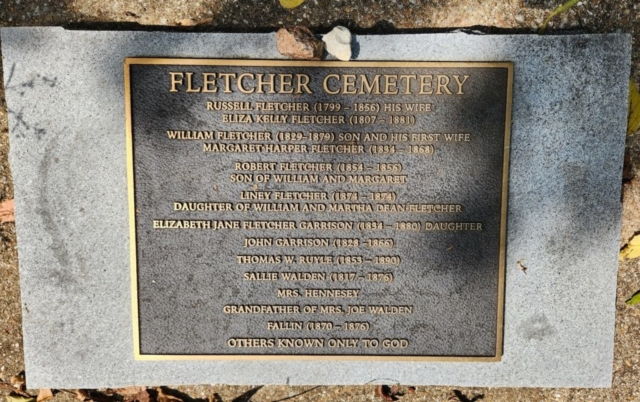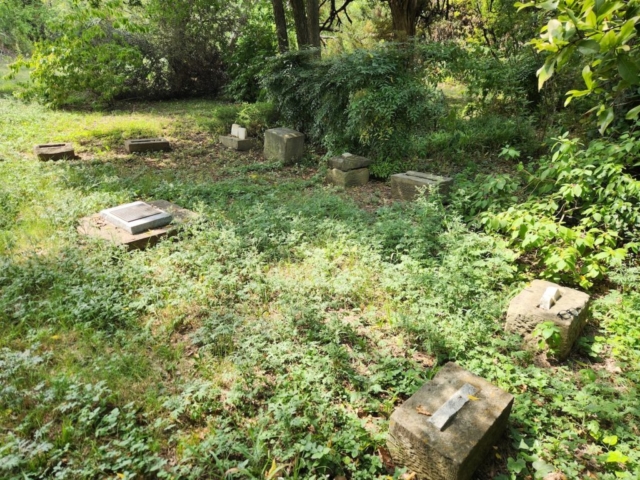By Frances James (1922 – 2019)
The entrance to the Fletcher Cemetery is down the alley behind the houses that face either 800 Block of Carney or 2500 Glenbrook in Garland. There are small signs at the entrances to this shared alley that say “Cemetery.” Whether the people who own the houses or the Garland City officials want the cemetery to be there or not – that is where it is. Longtime Garland residents say they remember that it was “out in the field.” This Cemetery has been called the Axe, or the Loudermilk, but the correct name should be the Fletcher Cemetery.
The land the cemetery is on was a part of the W. H. Keen Survey No. 734 that shows up on Sam Street’s Map of 1900 very near Duck Creek. Tennessee native William H. Keen had received 640 acres of land from Peters Colony when he migrated to this area from Indiana in 1846. Keen’s deed signed by Governor Elisha M. Pease was filed in 1855. Listed as family number thirty-eight on the 1850 census, William and Susanna Keen brought their three children and the baby was only one month old when this first federal census for Texas was taken. There was no way that William Keen could farm 640 acres of land so he sold portions of it to the new settlers who came to Texas.
Dallas County Deed Records reveal that Russell Fletcher (1799-1856) purchased 160 acres of land in the Keen Survey in 1854. A native of Kentucky, Russell Fletcher married Elizabeth Ann Kelly in 1824 in Overton, Tennessee. They moved to Shelbyville, Illinois in 1836. The town of Shelbyville was founded in 1827 and this town just south of Decatur, Illinois as of 2000 only has a population of less than 5000. 1850 census for Shelby County, Illinois, noted for its rich farmland, revealed that Russell Fletcher was the County Judge and his real estate was valued at $2000.00. The entire Fletcher family of three sons and six daughters moved to the Duck Creek area in 1854.
After only two years in Texas Russell Fletcher died but in that time he had purchased several parcels of land, about 285 acres, along White Rock Creek and Duck Creek. Since he did not have a will his son, John L. Fletcher (1827-1870), was appointed administrator of the estate in the Probate Court Records for the June Term 1856. Russell Fletcher’s lawful heirs were his wife Eliza and their children; John L. Fletcher, William M Fletcher, Mary Ann Smith, Elizabeth Garrison, Virginia Spong, Julia Ann Fletcher (later Dixon), Thomas B Fletcher, Margaret P. Fletcher (later Jones), and Harriet Fletcher (later Waller). Russell Fletcher is the first known burial in the Fletcher Cemetery. When Eliza died in 1881 she was buried next to Russell.
William Fletcher (1829-1879) and his wife Margaret Harper settled on land near Breckenridge, but in 1858 purchased a farm nearer Garland. In 1863 Margaret died leaving four children. Her broken headstone in the Fletcher cemetery was inventoried in 1973. It stated that she was the first wife of William Fletcher who is also buried in this site.
Thomas Ruyle (1853-1890) had been a tenant farmer in Garland but by the time he died he had purchased 57 acres of land on “Duck Creek.” He was buried in the Fletcher Cemetery. His headstone said he was the husband of Mary Jane Lewis. The Lewis family lived in what is now the Sunnyvale area of Dallas County. There were other members of the Ruyle family in Rowlett. Thomas Ruyle’s grave marker was still erect in this cemetery as late as 1979, it is now gone. There was a picture in the paper one time and other private individuals have photographs in their personal collections documenting his head stone.
There was a broken head stone with only the dates still legible when the inventory was made in 1973. These dates (28 Jan 1828 – April 1867) correspond with the birth and death dates of John Garrison, the husband of Elizabeth Jane Fletcher (1834-1867). Elizabeth and John were married in Illinois before coming to Texas.
Mrs. Joe Walton, who was a resident of Garland when interviewed in 1965, said her grandfather was buried there, but she did not know where now that so many stones had been taken away. She said it was pasture land until the Orchard Hill Estates, an addition to the City of Garland, was developed around 1960.
In an article about the cemetery in 1965 there was a picture of the grave marker for Sallie Walden, born January 23, 1817 and died August 20, 1876. This marker was made of metal but was gone before the 1973 inventory was made.
The Fletcher family was involved in many aspects of the community in this area of Dallas County. Uriah Spong (1832-1913) who drove one of the wagons when the Fletchers came to Texas in 1854 married fifteen year old Virginia Fletcher in July 1855. Uriah wasted no time as he purchased 230 acres of land in the Solomon Dixon Survey in December 1854. After serving in the Confederate army he returned to Dallas and he and Virginia moved to Rockwall in 1883 where they helped establish the Christian Church there. They later moved to Kaufman then to Denton in 1903. Many of their descendants have continued as active members of the Christian Church.
Martha A. Fletcher, the daughter of Thomas B. Fletcher (1842-1886), and Sallie Hill married Ed C. Smith, who had one of the first and foremost funeral homes in Dallas that is still in operation. In an article in the Daily Times Herald in 1903, concerning known cemeteries in Dallas and some of the surrounding towns, he does not mention this one where his wife’s family is buried. Ed Smith was the son of Colby Smith who was quite prominent in the establishment of Christian churches in this area.
When the First Christian Church in Garland celebrated their 100th Anniversary in 1975, a book was prepared by Dr. Chester L. Cole, minister emeritus. Much of the information contained in this story about the Fletcher Cemetery was derived from this book. Since that time descendants who no longer live in this vicinity have gladly forwarded their personal documentation on their side of the family. When the First Christian Church was organized in Duck Creek many of the Charter Members were of the Fletcher family. A plaque in the entryway of the church now on Glenwood and Ave. A in Garland, Texas has the names of 21 charter members of the Church organized in 1875 and several Fletcher names are on the plaque. They not only started this church but descendants were active in starting other Christian Churches in North Texas. In the history of the establishment of Christian Churches in Texas the Fletcher family is mentioned.
The Fletcher Cemetery is one of the oldest in the eastern section of Dallas County and the people buried here were some of the first residents in the area. In an attempt to understand the names that have been used for this site, recent conversations with Axe family members said it was just a small cemetery in a large field. The Charles Axe family came to Dallas from New Orleans in 1873 and purchased some of the land previously owned by the Fletchers. There may be one member of the Axe family buried in this site, but no one knows where. When interviewed in 1965, J.D. Carney, whose wife’s maiden name was Axe, said that some of the bodies had been dug up and moved. He did not know where they went. No records have been found of this account.
An attempt was made to contact the Reverend Charles R. Leech, the rector of St. David’s Episcopal Church in Garland in the late 1960s who lived in the rectory nearby on Carney Street. In an article with a picture in the Dallas Times Herald in 1965, Charles T. Leech, Reverend Leech’s son, said that when they moved into the rectory in the 1960s most of the stones were still there. Little by little the stones disappeared. He said there were some head stones lettered in Spanish. In the picture in the paper Charles T. is looking at a grave marker made of zinc for Sallie Walden (1817-1876). The Leeches said they had kept the area mowed since it was not maintained by the City. Schoolmates of the Leech boys who attended Garland High School with the boys said they did not know what happened to this Episcopal family after they left Garland.
From time to time, through the years, attempts have been made to protect this cemetery site, but due to innocence or ignorance of the law that should protect cemeteries in Texas, these citizens’ attempts did not accomplish their goal. Interviews with various neighbors have described the size it once was and the headstones or some sort of markers that were there. It has been estimated that there may have been 100 graves in this site now treated as an alley. There was an inventory made by the Dallas Genealogical Society of Dallas County of the cemetery in 1973 that listed only eight stones still visible. In a survey in 1979 five of those stones were missing, but there was evidence of twelve additional graves. Various trucks used this cemetery as an alley and even destroyed one of the fences on private property trying to maneuver around the corner.
In May 2008 a group of interested people decided to look for lost head stones by probing. A corner of a stone that protruded from the ground was found and when the site was uncovered by shovels, a pickax and a strong pry bar, it was discovered that twelve bases had been shoved into a pit and buried. All of the tops of these bases had been broken off or removed and all the information was gone. The 1973 inventory had mentioned that about twelve bases remained at that time. The bases were all unearthed and placed in a semi-circle around a small slab of concrete with a bronze plaque in the center with the names of all known burials of these pioneers. Fletcher family members from around the United States attended the dedication of the marker at the site. It is hoped that the neighbors in the surrounding houses will respect this hallowed ground and help maintain the final resting place of these settlers.
Frances James, “Dallas County History – From the Ground Up, Book II,” 2009.
Photos of Fletcher Cemetery:





